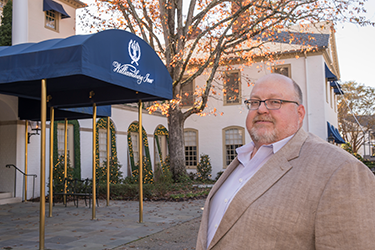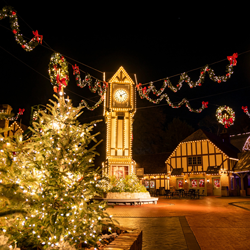Hope springs eternal
After tough pandemic season, Williamsburg seeks 2021 renewal
Hope springs eternal
After tough pandemic season, Williamsburg seeks 2021 renewal
As of late October, with capacity restrictions gradually lifted, Williamsburg was striving to get back on its feet. Colonial Williamsburg began welcoming visitors back in June, with most of its interpretive programs moved outdoors. After being shuttered for most of the summer, Busch Gardens opened for limited capacity events in August. Other businesses, including those that rely on tourist dollars, also have reopened, and William & Mary students returned to campus in mid-August.
However, don’t expect a return to business as usual for Williamsburg, which in March was named the South’s best small town in a reader survey conducted by Southern Living magazine. Local leaders say the pandemic has underscored the area’s dependency on tourism and they’re pressing to diversify the region’s economy before the bottom drops out again.
“COVID-19 exposed our vulnerabilities and forced our community to hit the reset button,” says Voncile Gilbreath, executive director of the Greater Williamsburg Partnership (GWP). The 4-year-old economic development organization, which represents the Williamsburg area, including James City and York counties, had already been looking at economic diversification before the coronavirus hit. “We want to look at where we can lessen our dependency on tourism and move forward. This is the time to get it right.”
In 2016, GWP commissioned an analysis of greater Williamsburg’s economic and labor assets, which identified advanced materials and components, food and beverage, and professional and technical services as emerging sectors, along with tourism and defense as legacy industries. This fall, GWP received a $36,375 grant from the state’s GO Virginia economic development initiative to update the analysis.
“Time is of the essence,” Gilbreath says, noting that other economic sectors could be added to the list. “People in hospitality and tourism are out of work. We want to make sure we’re moving forward with solutions right away and direct those who have lost their jobs to new positions so we don’t lose those employees out of greater Williamsburg or Virginia.”
Expansion plans
Home to more than 156,000 residents, greater Williamsburg’s location between Hampton Roads and Richmond allows it to draw from both regions’ economic and workforce assets. In addition, the widening of Interstate 64 on the Peninsula, along with massive investments through the Port of Virginia, puts the area in a good position to attract new businesses, such as South Korean manufacturer Navien Inc. A manufacturer of tankless water heaters and coolers, Navien announced in March that it plans to invest $77.5 million to establish its first U.S. manufacturing and assembly operation in James City County, with the plant expected to begin manufacturing in 2023.

Other companies expanding into greater Williamsburg include Delaware-based T-Rex Ventures LLC, which in July unveiled plans to build a $60 million data center at York River Commerce Park in Yorktown. Under an agreement with the York County Economic Development Authority, T-Rex Ventures has until
Jan. 31, 2021, to purchase the property from Dominion Energy Inc. in order to receive economic development incentives, including a $1.48 million grant. The project is expected to be completed by summer 2022.
Meanwhile, Midtown Row is being promoted as Williamsburg’s new city center. Located near William & Mary, the mixed-use development from Bethesda, Maryland-based Broad Street Realty Inc. will have office and retail space and 240 apartments when it is completed in summer 2021.
“They’re doing things to think outside the box,” Gilbreath says. “There’s a lot of history here, and one of the things that makes the area such a great place to live is all of the amenities in greater Williamsburg.”
Pursuing new economic sectors will not eclipse the importance of tourism for the Williamsburg area, however, says Gilbreath. “It’s not going anywhere, and we don’t want it to go anywhere, but we want it to be robust and make it the best, high-quality experience people can have.”
Those efforts include pursuing new ventures to promote tourism, including a regional sports complex. “We already have hotels, restaurants and attractions. This would generate more room nights,” Gilbreath says. Such a facility also could help the area in its efforts to attract the USA Field Hockey Association, which is seeking to relocate its national headquarters from Colorado Springs, Colorado.
Economic diversification is a lofty goal, counters Ron Kirkland, executive director of the Williamsburg Hotel & Motel Association. “You can do small things to diversify the economy, but is the next Facebook or Google going to locate in Williamsburg? It’s possible, but not likely.”
Although he agrees that an indoor sports facility would draw more people to the area and introduce them to its historic attractions, Kirkland questions Williamsburg’s commitment to bringing it to fruition. “If tourism performed like it did 20 years ago, we wouldn’t be talking about the need to diversify,” he says. “We have to invest in new products to get people to come here, but we don’t have the will to act.”
A ‘devastating’ lodging year

The Williamsburg Tourism Council, the area’s marketing arm, has launched an aggressive advertising campaign, assuring potential visitors that Williamsburg is open and employing comprehensive safety measures. “Given the influx of new visitors to our website, I’m confident that maintaining the region’s promotions will result in an expedited recovery,” says Victoria Cimino, the council’s chief executive officer.
According to Smith Travel Research, the region’s hotel occupancy rate hit an historic low of 10.5% in April, climbing to 36.5% by August. “That’s certainly not where we had hoped or wanted to be at the beginning of 2020, but we’re slowly moving in the right direction,” Cimino says.
In terms of revenue and occupancy rates, COVID-19 and the resulting shutdowns of Colonial Williamsburg and Busch Gardens have impacted Williamsburg more than any other Virginia destination, Kirkland says. Lodging revenues in Williamsburg were down by 49% for the first week of November, compared with the same period in 2019, according to STR Inc., a division of CoStar Group that provides market data on the hotel industry.
“It’s devastating,” Kirkland says. “No one is making a profit right now — not a single hotel in town.”
Many of Williamsburg’s more than 60 lodging establishments have taken on additional debt, he adds. “They’re doing everything they can to limit expenses and holding on long enough until we get past this health crisis.”
Easing capacity restrictions at attractions such as Colonial Williamsburg and Busch Gardens is key to filling hotel rooms, Kirkland says. “We don’t want 30,000 people at Busch Gardens, but could we have 10,000? One thousand people [at a time] is just not enough.”
As of early November, Virginia remained under Phase Three of Gov. Ralph Northam’s Forward Virginia pandemic reopening plan. Phase Three limits amusement parks such as Busch Gardens and Hanover County’s Kings Dominion to a maximum of 1,000 patrons. With the nation seeing record numbers of daily COVID-19 cases, it was uncertain when the state government might increase restrictions at some point during the winter.
Busch Gardens reopened in August, September and October for a series of reservation-only events with strict attendance limits. Although only select villages, rides and eateries were available, park officials say the reopening was a success. “Demand was great, and our guests were overwhelmingly positive,” says Kevin Lembke, president of Busch Gardens Williamsburg. In November, the park launched a limited-attendance version of its annual Christmas season — albeit on a much smaller scale than in previous years — to finish out the year.
“We have to get creative and stay creative,” Lembke adds. “The 1,000-person limit certainly makes it difficult for a business this size to operate in a way that makes sense. What we’ve offered is a sampling of what we do.”
Only 10% to 15% of Busch Gardens’ 4,000 employees are working during the limited reopening. “That has certainly been one of the more difficult impacts,” Lembke acknowledges. “As business resumes, our goal is to grow the workforce.”
He adds that Busch Gardens hopes the park will be back to regular operations by the time it opens for its 2021 season in the spring. “It comes down to what restrictions we may or may not be operating under.”
But even if Busch Gardens and other attractions are in full swing next year, Kirkland says, Williamsburg hotels and motels will still feel a pinch. “It will take 18 to 24 months for lodging to recover. As we get into 2021, we can really market the heck out of the destination and have a great spring leading into a great summer, but we can’t do this again.”
Meanwhile, the Greater Williamsburg Partnership and the Williamsburg Community Foundation partnered with Williamsburg and James City and York counties’ economic development authorities to assist small businesses impacted by the pandemic. About 125 businesses have received $3,000 grants through the Greater Williamsburg Small Business Relief Fund, which worked with the nonprofit Virginia 30 Day Fund to administer the grants.
The grants don’t require repayment, explains Ginny Gasink, the foundation’s development and communications officer, but companies are encouraged to do so if they can. “We know this problem will be going on for a while. If at some point in the future, they want to pay it forward back to the community in some way, they can.”
Williamsburg-based Bicast Laser has already done that. The family-owned company, which makes customized souvenirs for tourist spots, moved into a larger facility just two months before the pandemic hit. “One hundred percent of our customers closed,” says owner Stacy Harris. To keep employees paid and assist front-line health care workers, Bicast Laser pivoted its operations to manufacturing protective face shields, producing more than 25,000 during April and May.
“It wasn’t super profitable, but it kept the doors open, and we were able to keep all of our employees on,” Harris says, adding that she used the relief grant to meet payroll. “Even if we made a zillion face shields, the material was very expensive. We have a lot of single moms working for us. Just keeping them on was very important to us.”
That’s the type of ingenuity, combined with flexibility, that economic development officials believe will jumpstart Williamsburg’s economy. “Everything is possible,” says Gilbreath. “We are all just learning to adapt and be flexible and receptive to change, but we have opportunities.”
<


















